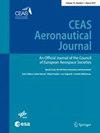液氢储存的设计取代了短程飞机的概念
Q2 Engineering
引用次数: 4
摘要
摘要介绍了某型近程飞机液氢存储系统的初步设计方案。两种有前途的保温方法,即硬质泡沫和多层保温,被认为是主要的设计驱动因素。此外,最大压力和储氢罐的形状也会影响飞机的性能和保温效率。在本研究中,储氢罐集成在机翼吊舱中。采用概念和初步方法分析了由设计参数驱动的主要影响因素:建立了储氢质量、附加阻力、螺旋桨效率损失和液氢储氢动力热力学行为的模型。这些影响是相互耦合的,因此有必要采用综合设计方法。针对液氢储存库的尺寸确定问题,建立了考虑飞机对设计任务块燃料敏感性的多学科工作流程。权衡研究揭示了隔热效率与飞机性能之间的相反趋势。对于基于刚性泡沫的隔热结构,储罐在飞机水平上的损失和氢气排放的损失可以得到平衡,从而使设计任务中的块燃料最小化。多层隔热材料的应用避免了设计任务期间的通风,但与刚性泡沫隔热材料相比,对飞机性能的影响更大。除了最小块燃料标准外,还比较了休眠时间,表明热效率。应用多层绝缘材料,休眠时间可以显著增加,这需要讨论氢动力飞机的操作要求。本文章由计算机程序翻译,如有差异,请以英文原文为准。
Liquid hydrogen storage design trades for a short-range aircraft concept
Abstract Preliminary design trades for the liquid hydrogen storage system of a short-range aircraft are presented. Two promising insulation methods, namely rigid foam and multilayer insulation, are identified as main design drivers. In addition, the maximal pressure and the shape of the hydrogen storage tank influence the aircraft performance and the insulation efficiency. In this study, the hydrogen storage tanks are integrated in wing pods. The main effects driven by the design parameters are addressed using conceptual and preliminary methods: models are carried out for the storage mass, additional drag, propeller efficiency loss and the dynamical thermodynamic behavior of the liquid hydrogen storage. These effects are coupled making an integrated design method necessary. For the sizing of the liquid hydrogen storage, a multidisciplinary workflow is set up including the aircraft sensitivities on the design mission block fuel. The trade-off study reveals the opposing trend between insulation efficiency and aircraft performance. For the insulation architecture based on rigid foam, the penalties implied by the storage tank on aircraft level and the penalties due to vented hydrogen can be balanced and result in minimal block fuel for the design mission. The application of multilayer insulation avoids venting during the design mission, but has an increased penalty on the aircraft performance compared to rigid foam insulation. Besides the criterion of minimal block fuel, the dormancy time is compared, indicating the thermal efficiency. Applying multilayer insulation, the dormancy time can be increased significantly calling for a discussion of operational requirements for hydrogen-powered aircraft.
求助全文
通过发布文献求助,成功后即可免费获取论文全文。
去求助
来源期刊

CEAS Aeronautical Journal
Engineering-Aerospace Engineering
CiteScore
3.40
自引率
0.00%
发文量
53
期刊介绍:
The CEAS Aeronautical Journal has been created under the umbrella of CEAS to provide an appropriate platform for excellent scientific publications submitted by scientists and engineers. The German Aerospace Center (DLR) and the European Space Agency (ESA) support the Journal.The Journal is devoted to publishing results and findings in all areas of aeronautics-related science and technology as well as reports on new developments in design and manufacturing of aircraft, rotorcraft, and unmanned aerial vehicles. Of interest are also (invited) in-depth reviews of the status of development in specific areas of relevance to aeronautics, and descriptions of the potential way forward. Typical disciplines of interest include flight physics and aerodynamics, aeroelasticity and structural mechanics, aeroacoustics, structures and materials, flight mechanics and flight control, systems, flight guidance, air traffic management, communication, navigation and surveillance, aircraft and aircraft design, rotorcraft and propulsion.The Journal publishes peer-reviewed original articles, (invited) reviews and short communications.
 求助内容:
求助内容: 应助结果提醒方式:
应助结果提醒方式:


